June 21, 2015
We were discussing the various possibilities for kayaking, and wanted to leave some of the best stuff for a visit from James’s daughter and/or my son. On this day we settled on few hours of kayaking on Neroutsos Inlet, which included the Frigon Islands and the lighthouse.
Some of you might be wondering about the names of our inlet and the islands in them. Yes, “Neroutsos” does sound a lot like the psychological disorder and Frigon sounds like a substitute swear word. Back in the seventies, when the mill dumped pollution into the inlet indiscriminately (before they seriously cleaned up their act because of new government regulations), people who were opposed to it would call it, “Neurosis Inlet.” Well, the name “neurosis” seems to have stuck. When I came here in 2010, practically anyone I’ve talked to has pronounced the name like the psychological disorder. If you look closely at the name “Neroutsos” and follow the rules of English pronunciation, it should sound a little different. It doesn’t flow smoothly off the tongue, however, which is probably why people tend to default to “neurosis.”
The name “Neroutsos” actually has a very honourable origin. It was the name of a hardy and heroic big wig and pioneer in the development of navigation in western coastal waters, Captain Cyril Demitrius Neroutsos. Born into a wealthy shipping family in 1868 in Bowden, Cheshire, England, his considerable metal was soon tested when he became an orphan at age 13. With barely any time to grieve his circumstances, he set out on the high seas as an officer cadet. In addition to trade excursions around the globe, he ended up participating in the New Zealand to London clipper ship races around the Cape. By the time he reached 18, he had sailed around the world four times! With the arrival of steam, Neroutsos acquired his papers for deep sea master and signed on with the British India Steam Navigation Company. This brought him to Seattle during the Klondike Gold Rush where he became marine superintendent for the Frank Waterhouse Company. In 1901, he switched over to the Canadian Pacific Navigation Company; and, because of his qualification as a lieutenant Commander in the Royal Naval Reserve, he was promoted from marine superintendent to Manager of the costal fleet. Although his knowledge of the deep seas was impeccable, he signed on as a mate on the S.S. Islander in order to gain more familiarity with coastal waters. While he was asleep in his quarters, the ship struck an iceberg off the shores of Alaska and sank in 20 minutes. As soon as the ship struck, Neroutsos went knocking on cabin doors, waking up passengers and assisting people onto the deck. The last man off the deck before the ship disappeared into the sea, he continued his heroic feats in the water. A strong swimmer and apparently impervious to the frigid Alaska water (I can’t even handle the water down here in the middle of the summer!) he helped save a man with an injured leg by lifting him onto a door from the wreckage. Incredibly, he stayed afloat in the water until help arrived! When he was found, Neroutsos was hypothermic, but holding an unconscious girl on his shoulders who survived because of his efforts. There were many causalties from the sinking. Neroutsos was the only executive officer to survive.
Despite this legendary account, Neroutsos is remembered because he was able to make sweeping advancements in coastal navigation in a single lifetime, keeping people as safe as possible in the relatively uncharted waters of the New World.
Ed Frigon, after whom our islands are named, was another unbeatable North Island pioneer. Hailing from Maurice Quebec, he set out to make it big in the California Gold Rush of the 1850s. When things did not go his way there, he set his compass for a life of adventure in the Pacific Northwest. After working a few years in Victoria to save money, he chartered a sealing schooner for Hope Island (Bull Harbour) in 1857. He spent 32 years running a fur trading post for local First Nations and passing sealing and whaling ships. In 1895, he moved to Limestone Island, now called Drake Island, in the Quatsino area. This is the island that we saw on our paddle from Atkin’s Cove. It is interesting to think that this lonely looking uninhabited island was once a happening place! In Quiet Cove (now called Pamphlet Cove), in the middle of the Island, Frigon opened a trading post, a floating wharf and a three storey hotel with fourteen rooms and a saloon! The hotel ran for 8 years before it was shut down mainly because of prohibition in 1917. An elderly Ed Frigon then moved to a large homestead north of Port Alice to spend his remaining days with his late in life love interest First Nations woman and “Last of the Longheads,” Lucy Moon, who was about 50 years his junior.
Frigon was only 5’2”, but he was strong as an ox, with a personality to suit. A true pioneer, he chose to live in a remote part of the world where there were very few white people, and probably not a single Francophone! Not only did he survive life in the wilderness, he found a way to make a living. He gave commerce on the North Island a serious jump start in the process. He was so much the heartbeat of commercial life of the community that his influence continued even after he passed away. A general store in Quatsino that opened shortly after his death was named after him. Lucy Moon remained living on Frigon’s property, and, after teaming up with Nip Wong, worked Frigon’s land and supplied Port Alice with fresh produce for many years. Frigon’s hotel was floated down to the old Port Alice townsite and renamed “Jones’s Hotel” and used for housing mill workers. It was also used as a community dance hall that was probably the starting point of many Port Alice romances. The hotel was finally destroyed in the mid-1960s, along with the rest of the buildings of Old Port Alice, when the town site was moved to Rumble Beach. Probably every transaction that happens and every child that is born on the North Island since is, in some way, touched by the ghost of Ed Frigon.
We were getting pretty fast at loading and unloading the kayaks. We launched at low tide at the Marina, but not at the boat dock because I think you have to pay. We passed boats and a pole coated with mussels going up to the highest tide level. We were heading in the direction of the Frigon Islands. We passed around the north side, seeing the rocks encrusted with barnacles and plant life in a variety of hues. When you launch at low tide, you get to see everything that lives under the water part time! When we came around the other side, we found a small cove with a pebbly beach. We decided this was to be the place for our snack when we were ready.
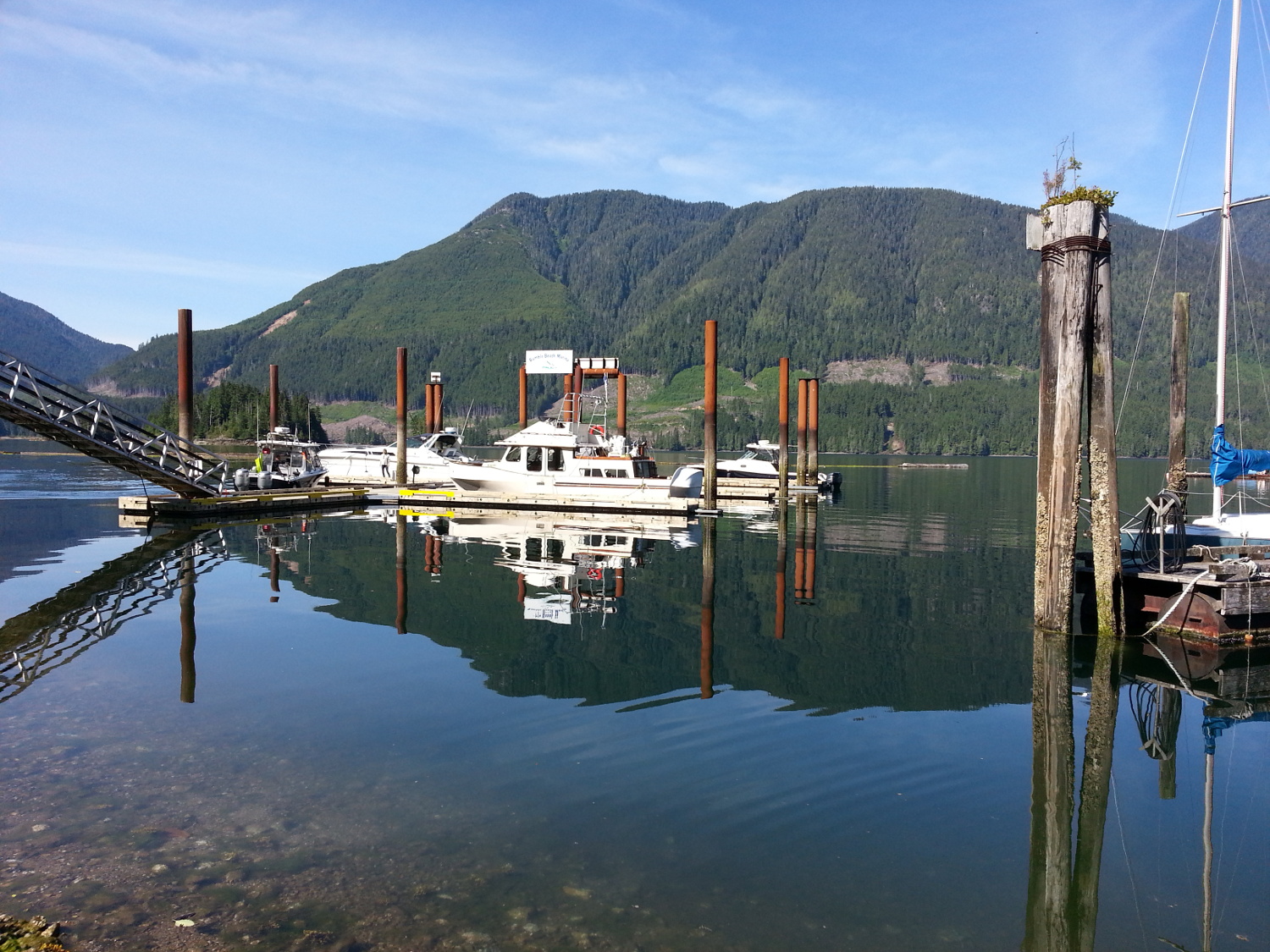 Port Alice Marina 1.
Port Alice Marina 1.
 Port Alice Marina 2.
Port Alice Marina 2.
 Pole with Mussels.
Pole with Mussels.
We contemplated visiting some friends who lived across the inlet. We had started out quite late (we slept in), so we had missed the best part of the day for paddling on calm waters. We headed in that direction, but chickened out part way there. We were suspecting the waves would get choppy soon from the inflow winds. For those of you who don’t know what inflow winds are (I just learned this recently), they are produced when the mid-day heat from the inlet rises up and creates a gap for cooler winds to come rushing in from the ocean. When the winds come rushing down the inlet, not only does it create wind resistance, it makes for higher waves, and, depending what is happening with the tides and the currents, it can make for complicated boating in general. Neroutsos Inlet is a great place for low key kayaking, what I like to call “Chihuahua kayaking”— or family kayaking, as it is sheltered from the rough waters of the ocean by mountain ranges. It is not like some places around Tofino that have breakers and high waves which are good for surfing and more acrobatic kayaking. On the inlet, you only have to work around the inflow winds; but, even then, they are only a bit challenging. You will get a good example of this later in this account. Generally speaking, to get calm easy kayaking, you should do it in the morning. Unfortunately, James and I are not morning people, but we’re working on it.
I didn’t want to do the trip across the inlet either because we still hadn’t found a proper life jacket for Chloe. James recently went to Campbell River to get her a life jacket and take care of some other business. When he put it on Chloe, she didn’t look too comfortable. He had been looking for a life jacket for her for a while with little luck. Chloe is a small dog who is big around the middle. Most small dog vests tend to be too small and medium sized vests fit her around the middle, but nowhere else. We thought the tabs at the front of this latest one might be too bothersome for her small head. James said he saw one that would be better at Bosley’s, but they didn’t have her size. We decided to return the life jacket he bought and keep looking for a better one. This is not easy for us, as we live two and half hours from “civilization.” Shopping on the North Island hasn’t improved much since Ed Frigon’s time.
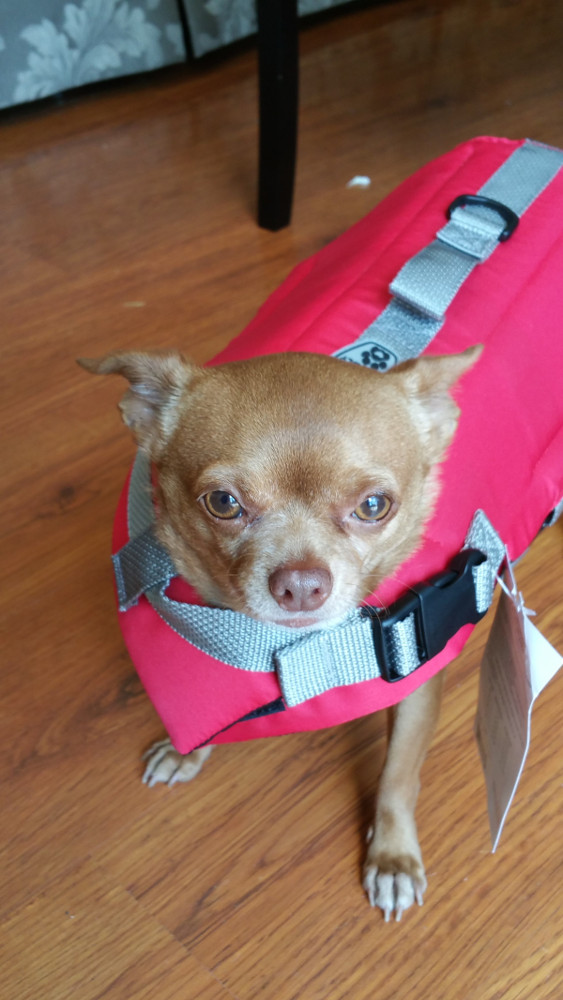 The not too comfortable lifejacket.
The not too comfortable lifejacket.
As we paddled around we saw a prawning boat and waited until it passed us. We were respecting the laws of the water: little boats yield to big boats. We then had a little fun bouncing up and down on the wake waves. Later there came a tremendously large sailboat with the sails down. We estimated its value at about a million. When we launched from the marina, we saw two boats that we estimated at 200 and 300 thousand. Such capitalists we are! We appreciate a boat’s beauty by its possible price tag! You have to admit that the price tag has a definite bearing on aesthetics! It just happens to be one aspect of appreciating something than most people can relate to. I mentioned to James that I thought this inlet should be full of such boats, as well as kayaks and canoes and such. I think Port Alice is a mini Monaco that has not been discovered yet.
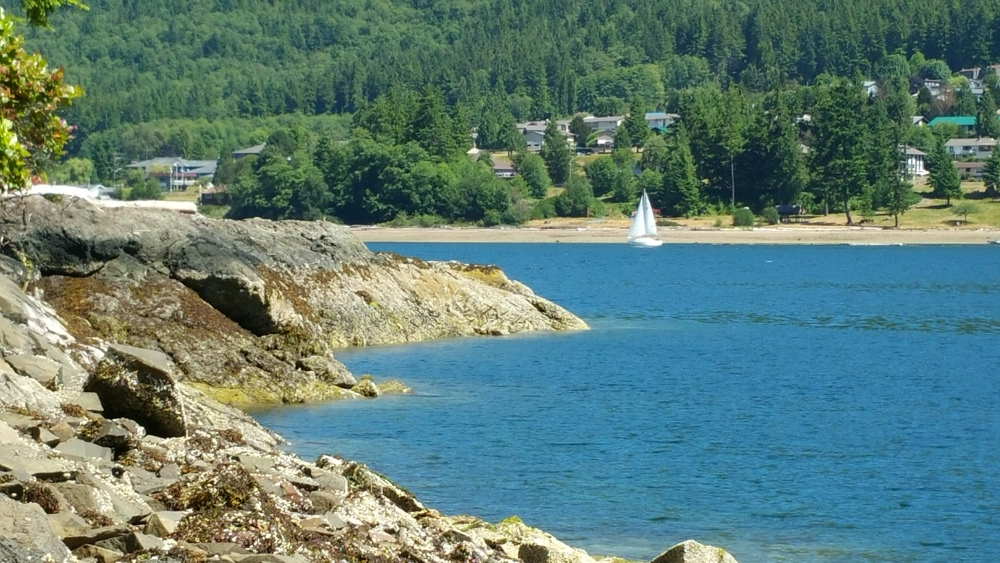 A burgeoning mini Monaco.
A burgeoning mini Monaco.
The water wasn’t very choppy, but we suspected it would be soon. By the time we headed back to the Island, it was past noon and we were hungry. As we landed, the tide was low so there was plenty of ground to walk on. We realized that high tide would leave only a narrow grassy patch between the two islands. It might even be completely submersed in a super high tide. There were remnants of a campfire right on that ridge. We contemplated how it would be fun to spend the night here, looking at the “bright lights” of Port Alice while sitting around a campfire. There is beauty to be found in human constructions, as well as Nature’s.
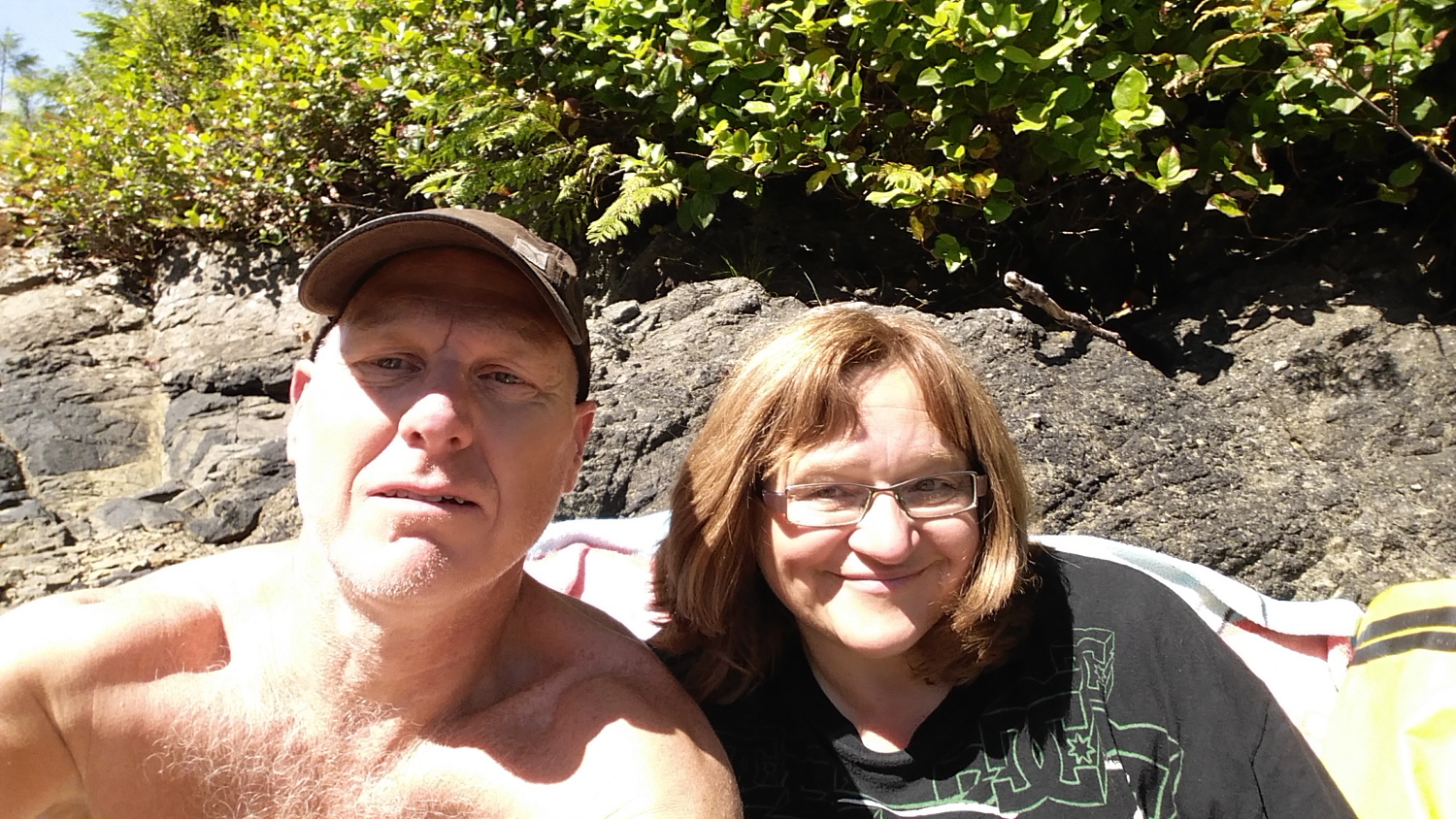 James and me on the Frigon Islands.
James and me on the Frigon Islands.
We sat down and had our lunch of hummus and rice crackers, cheese and blue berries. The crows on the Islands made quite a racket for quite some time, enough to start getting on our nerves. I’m not sure what the issue was, whether they felt we intruding on their territory or if they were excited about possible left overs and handouts. These crows were very different from the crows in Port Alice. The crows at the school, in particular, gather on the roof of the school at recess time, waiting in a row and quietly watching as the kids as they drop all kinds of goodies and crumbs on the ground. When the class bell rings they know it is their lunch time! These crows on the Frigon Islands were a little more “wild.” Their cawing was loud and hostile sounding. They did settle down eventually, though. I guess it was a different “tribe” of crows, with different customs and practices.
On the island, Chloe engaged herself in the doggie business of sniffing around for “doggie emails” and sending a few herself. Animals have their own version of the internet based on scent! After our snack, James, Chloe and I went searching for trails. The North part of the island was quite forbidding: it was tightly closed in with very thick trees and Salal. We found what looked like a trail opening on the south end of the island. We pushed through the Salal to find somewhat of a clearing that would be reasonably good for pitching a tent. We followed the very overgrown but still faintly discernible trail to the south end of the island and found a lookout perch with a rough hewnbench, another remnant of a campfire and one heck of a view! We could see some island lumps sticking out of the water. The view of the inlet was a high one, and we felt like we were on top of the world! It would be wonderful to sit and stare at it in front of a campfire around twilight and then watch the stars at night without fear of running into predators. Looking up from the lookout perch, we saw a weather worn old snag with all the crows sitting on it, by this time settled down. I took some nice shots of them, but most had flown away before I was able to get a really good one. I then took some nice shots of the view. We sat for quite some time in the sun and enjoyed the view. Chloe made herself comfortable under the bench in the shade. It was hot!
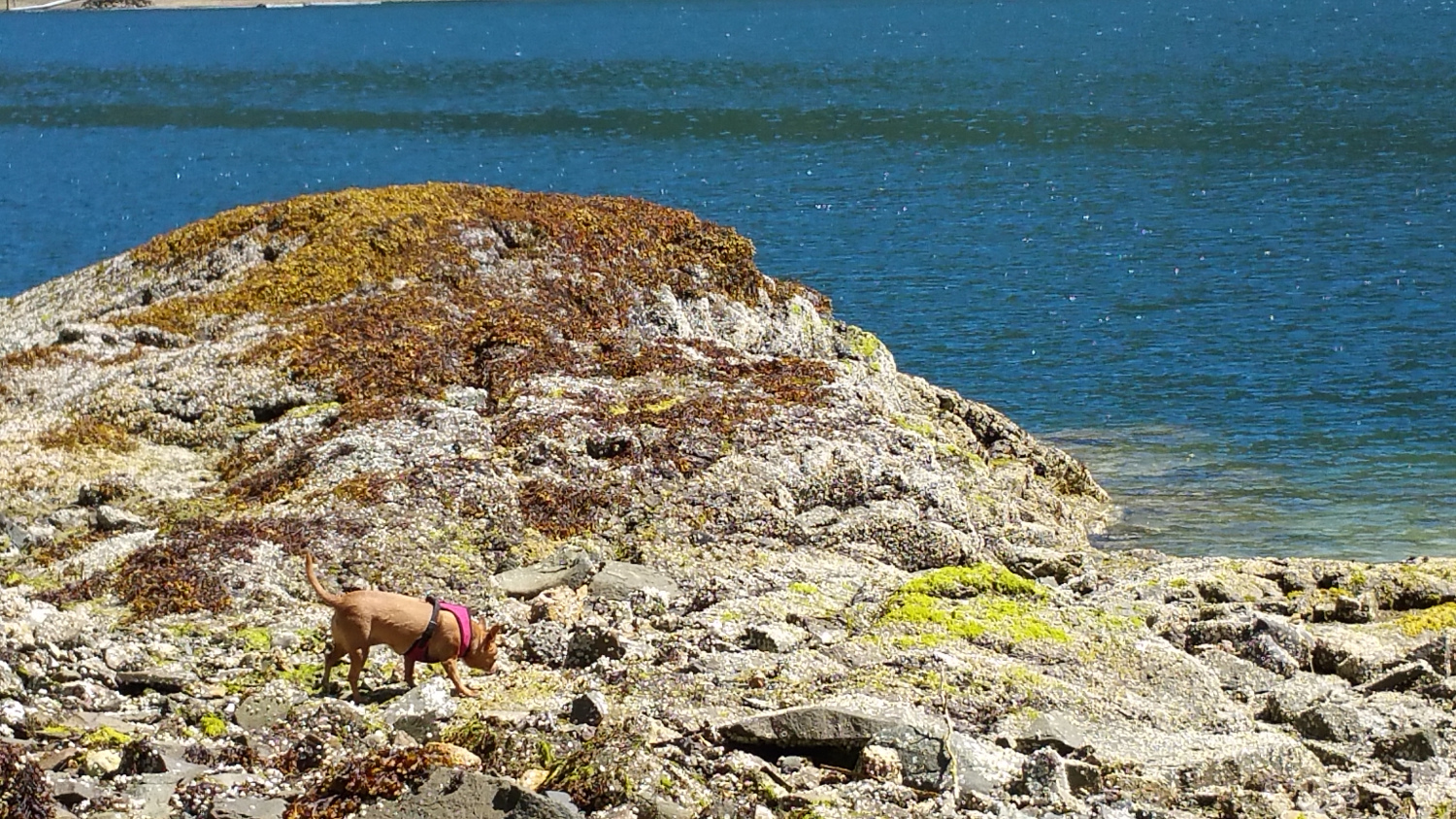 Chloe checking her inbox.
Chloe checking her inbox.
 Island lumps.
Island lumps.
 The rough hewn bench.
The rough hewn bench.
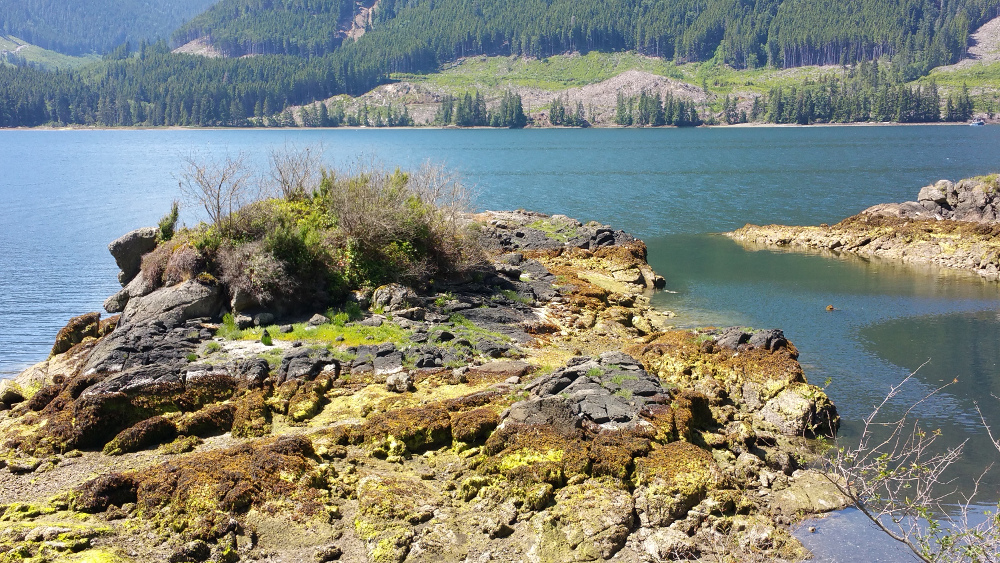 Cove entrance.
Cove entrance.
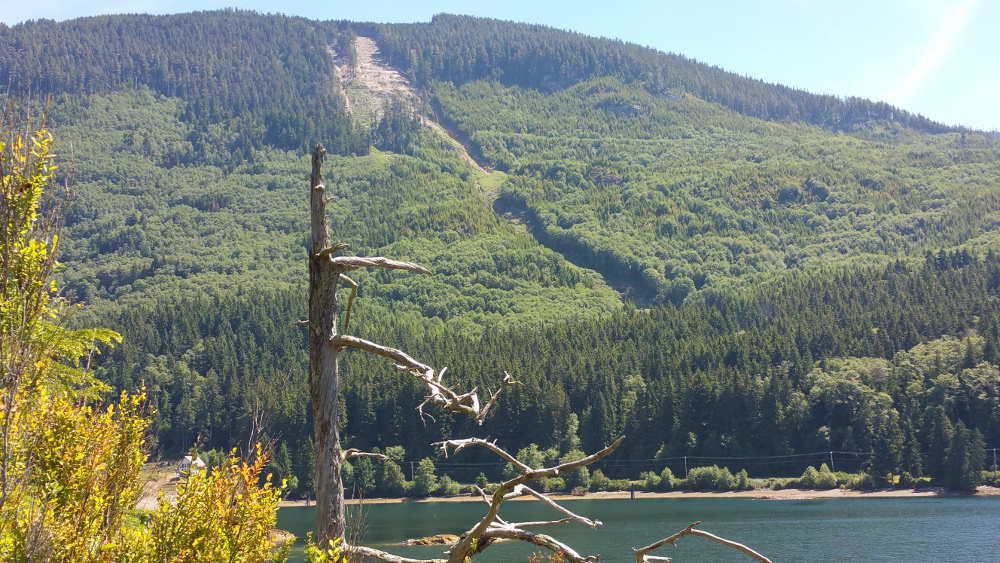 View of 2010 landslide.
View of 2010 landslide.
Instead of going back into the brush, we went around the rocks down to the cove and back to our landing spot. When we got back there, we discovered that the crows had cleared away our left-over crackers! No wonder they settled down! We went walking around the north side of the island looking for a trail in a few places but we were forced to turn back.
 The crows.
The crows.
There was a lot of sea asparagus on the island. James and I quibbled on how to pick them. I tried to pick them individually and he just pulled them up by the handfuls. I told him to be more selective, and just pick the nice bright green juicy looking ones. It also gives the plant a greater chance of surviving. James joked that he was fired. I said “Yeh, you are!” but he just kept on picking, though he did start to be more selective. I mentioned I could consult my Chinese cookbooks and make a stir fry with them with Chinese mushrooms, fresh mushrooms and maybe black beans. We started picking them where there was more shade, as that was where they seemed to be the greenest and juiciest. We picked a Ziploc container full and then some, which was too bad, because we ended up forgetting them and not realizing it until we got all the way back home.
Worried that the tide might take our boats away, James had tied them to a big piece of driftwood. When we arrived, the kayaks were sitting on rocks. By the time we were getting ready to leave, they were floating and James had to pull them in. As I was waiting for James to load up, I slowly paddled out to the mouth of the little cove and was peek-a-booed by a seal! Its head was just above the water and it was staring at me with a child-like curiosity for some moments before it ducked out of sight. I could definitely get a “vibe” from this seal. Just like I can get a good idea of what someone is thinking by their facial expression and body language, I felt a short merging of minds with this seal. It turns out, seeing us humans is as much of a novelty as seeing them is for us!
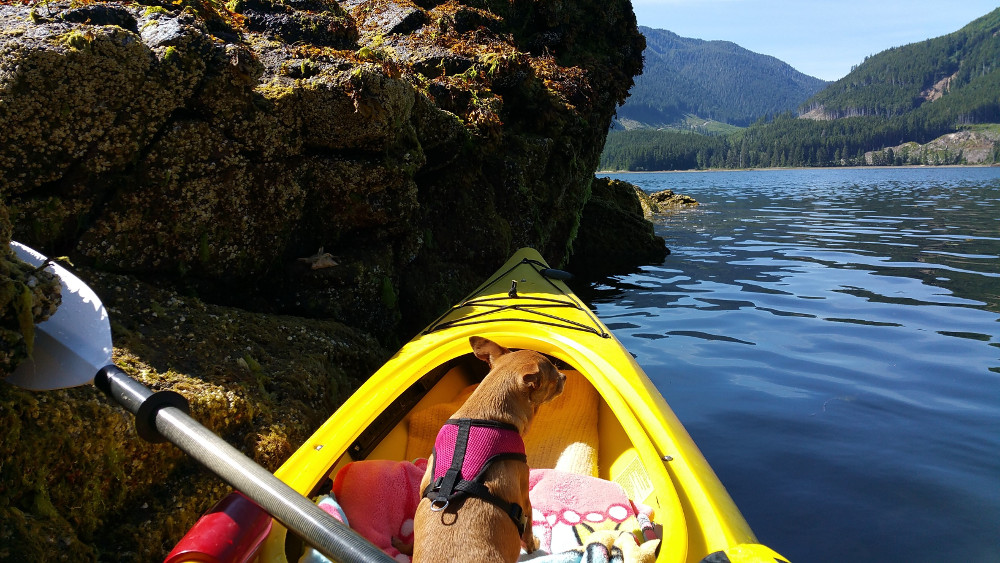 Where's Mommy?
Where's Mommy?
 Oh, There's Mommy!
Oh, There's Mommy!
 Artist at work.
Artist at work.
James was taking a while packing up and, used to him being so efficient and thorough, I didn’t worry about the sea asparagus that I left a little too far from our gear. We paddled around the south of the islands between the out-cropping of rocks, running into some kind of swimming grey fluffy water birds. Then, it was on to the lighthouse!
Having been a lookout, I have quite an affinity for lighthouses. I was determined to get there sometime and it looked like this was the day. We probably should have gone there first, because, by the time we were on our way there, it was well into the afternoon and the water was starting to get rough. We probably should have gone to the lighthouse first, then the islands. The water got rougher as we got closer to the lighthouse. I absolutely wanted a nice picture of the lighthouse, but my phone camera-- James’s old Galaxy 3--was out of battery. There was only James’ brand new Samsung Galaxy Note 4 that he just bought a few days ago in Campbell River that still had battery life—but he had it in his boat! Because the water was so rough and the current kept pushing us all about, we were having trouble getting coordinated. We were reluctant to pass the brand new phone from one kayak to the other for fear it would end up on the bottom of the inlet! Having a couple of art degrees, I’m pretty persnickety about how to take photos. I went to the place to show James where I wanted the picture to be taken from, but, after doing a little fiddling and looking away, the current had pushed me metres away from the desired position! I was also scared of getting too close to the lighthouse, for fear of crashing into it and losing my balance. It was a lot like being on a conveyor belt, with a large immobile jagged object at one end of it! Alas, I was unsuccessful at getting my message across. James took several photos, but they were not centred like I wanted them and probably not taken from the place that I wanted them taken. He suggested we could crop it.
 The lighthouse.
The lighthouse.
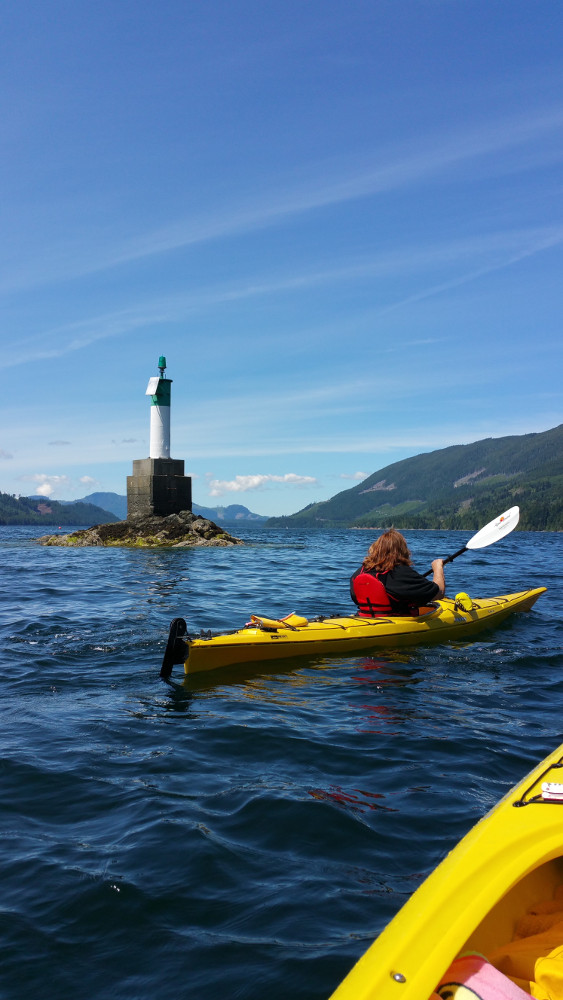 Frenzy around the lighthouse.
Frenzy around the lighthouse.
Between our battles with the current and the increasing choppiness of the water, we suddenly sensed an urgency to head to shore and abandon this business of getting a well-framed photograph. We were especially nervous since Chloe did not have her life jacket yet. We were bumping up and down on the waves, which was kind of fun albeit a little nerve wracking. We tried to head to shore but didn’t seem to be getting anywhere at all! We were aiming to head north to Jeune Landing and it was proving elusive as the current kept pushing us away from it. Finally, frustrated, I was determined to get out of this rough water. I said to James “race ya!” and engaged my paddling warp drive in the hopes of actually getting somewhere. It worked and the shore finally came in sight. James wasn’t too far behind me. We arrived at the shore, a bit south of Jeune Landing. The waves were still just as high as they were in the middle of the inlet and the current was still pushing us south. That short trip would have demanded a lot of power and we were just about spent! We gave up going to Jeune Landing and followed the shore back to the marina. We likely got ourselves on TV when we paddled by the Brooks Bay Cable weather camera. We complained how tired we were the whole way back, paddling slowly and meekly like we were a couple of 120-year olds (I was inclined to say 90 year olds, but I suspect that there are some 90 year olds out there who could seriously out paddle us!). Even Chloe was looking tired, though she didn’t have to paddle. She had emerged from her fleece and was sitting up, hot and panting, with her unusually big tongue hanging way out. We brought our two kayaks together and poured some water into her little red bowl so she could have a drink.
As is evidenced by our experience that day, boating can be pretty complicated. Between currents, tides, weather and the position of the sun, not to mention whatever may be under the water like reefs, whales and icebergs, you have to know what is going to happen in the water at any particular time and where exactly it will happen. Just think, our Captain Neroutsos had to have a good grasp of all these factors for the entire west coast—not to mention the fact that he knew this stuff for all the oceans around the world—and in a time before GPS and Google maps! It’s hard even to imagine! The guy definitely deserves to have an inlet named after him! Both Neroutsos and Frigon very much deserved their honours, as they both seemed larger than life. Now, after researching these two men, when I say “Frigon Islands on Neroutsos Inlet,” I no longer say it with a bit of a snigger, but with reverence.
Once we were on shore, we discovered we were more tired than we originally thought. My body felt like lead. We were even too pooped to wash down the kayaks. For the rest of the day we were virtually useless, doing minimal domestic routine like zombies, afflicted with something that only a good night’s sleep could remedy.
I would like to say a special thanks to Evelyn Hartford at the Port Alice Tourist Information centre for providing me with historical information for this and future blog entries. A lot of the history of Port Alice cannot easily be found in mainstream information sources. Thankfully, people like her are indispensable for keeping this information preserved and bringing awareness to that fact before it is forever lost to the passage of time.
I'd like to thank Gwen Hansen at the Quatsino Museum for providingme with information on Ed Frigon for this and future posts. I hopes she's right, and that someone makes a movie about "Old Ned" someday.